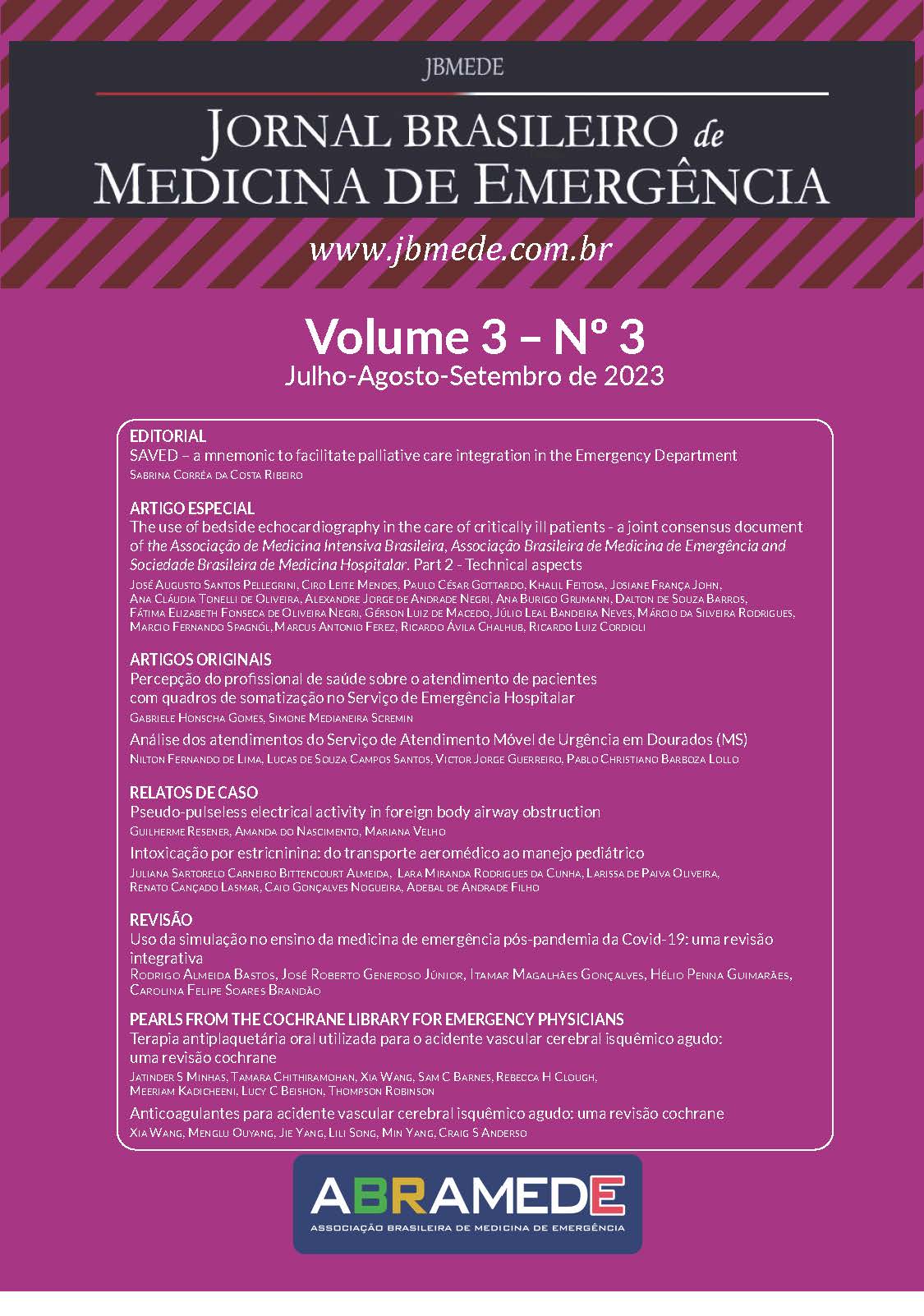Strychnine poisoning From air medical transport to pediatric management
Main Article Content
Abstract
Abstract: Vibration, light and noise are important flight stressors generated by aerospace physiology that directly impact the medical transport of a patient with a Strychnine intoxication, a toxic alkaloid extracted from the seed of Strychnos nux vomica, formerly used as a rodenticide, that was banned in the 90s due to its high lethality. Poisoning by the substance is rare and serious, and its management is complex. Case description: Patient, 2 years and 11 months old, male, admitted to the pediatric emergency department, via air transport, after suspected exogenous strychnine poisoning. The child received supportive treatment, with good response, and was discharged without sequelae. Discussion: This case report a very rare intoxication and correlate it with the need for protective measures for these flight changes, not only to improve teamwork, but primarily to prevent the poor clinical evolution of the victim. In addition, the specifics of the pediatric management of the victim are detailed. Such precautions can be extended to other pathologies that require restriction of noise, stimuli and vibrations. Conclusion: A quick detection, assertive management and measures that reduce stressful situations are essential for a good prognosis in Strychnine intoxication.
Article Details

This work is licensed under a Creative Commons Attribution 4.0 International License.
References
Referências Bibliográficas
Basualdo W. Intoxicación por estricnina [Strychnine poisoning]. Rev Med Chil. 1980 Feb;108(2):181-2. Spanish. PMID: 7244457.
Prat S, Hoizey G, Lefrancq T, Saint-Martin P. An unusual case of strychnine poisoning. J Forensic Sci. 2015 May;60(3):816-7. doi: 10.1111/1556-4029.12706. Epub 2015 Feb 20. PMID: 25702781.
Smith BA. Strychnine poisoning. J Emerg Med. 1990 May-Jun;8(3):321-5. doi: 10.1016/0736-4679(90)90013-l. Erratum in: J Emerg Med 1991 Nov-Dec;9(6):555. PMID: 2197324.
Yamarick W, Walson P, DiTraglia J. Strychnine poisoning in an adolescent. J Toxicol Clin Toxicol. 1992;30(1):141-8. doi: 10.3109/15563659208994455. PMID: 1542144.
Robert E. Gosselin, Harold Carpenter Hodge. Clinical Toxicology of Commercial Products: Acute Poisoning. Baltimore, Md.: Williams & Wilkins, 4ª edition, 1976.
Santhosh GJ, Joseph W, Thomas M. Strychnine poisoning. J Assoc Physicians India. 2003 Jul;51:739-40. PMID: 14621058.
Perper JA. Fatal strychnine poisoning--a case report and review of the literature. J Forensic Sci. 1985 Oct;30(4):1248-55. PMID: 4067548.
Brasil. Ministério da Saúde. Secretaria de Vigilância em Saúde. PORTARIA Nº 344, DE 12 DE MAIO DE 1998(*) - Aprova o Regulamento Técnico sobre substâncias e medicamentos sujeitos a controle especial. Disponível em : https://bvsms.saude.gov.br/bvs/saudelegis/svs/1998/prt0344_12_05_1998_rep.html.
Wood D, Webster E, Martinez D, Dargan P, Jones A. Case report: Survival after deliberate strychnine self-poisoning, with toxicokinetic data. Crit Care. 2002 Oct;6(5):456-9. doi: 10.1186/cc1549. Epub 2002 Jul 10. PMID: 12398788; PMCID: PMC130147.
Hur MH, Havalad V, Clardy C. Strychnine: Old Remedy, Silent Killer. Pediatr Ann. 2019 May 1;48(5):e205-e207. doi: 10.3928/19382359-20190422-04. PMID: 31067337.
Brunton, L.L. Goodman & Gilman: As Bases Farmacológicas da Terapêutica. 12ª ed. Rio de Janeiro: McGraw-Hill, 2012.
Starretz-Hacham O, Sofer S, Lifshitz M. Strychnine intoxication in a child. Isr Med Assoc J. 2003 Jul;5(7):531-2. PMID: 12901256.
Lambert JR, Byrick RJ, Hammeke MD. Management of acute strychnine poisoning. Can Med Assoc J. 1981 May 15;124(10):1268-70. PMID: 7237316; PMCID: PMC1705440.
Fábio A, Antoniuk SA, Bruck I, Santos LC dos. Tratamento do estado de mal epiléptico em pediatria: revisão e proposta de protocolo. J epilepsy clin neurophysiol [Internet]. 2005 Dec;11(4):183–8. Available from: https://doi.org/10.1590/S1676-26492005000400006
Mb I, Tonk RS, Sahu SK. A Case of Strychnine Poisoning. J Assoc Physicians India. 2020 Jan;68(1):105. PMID: 31979967.
Hur MH, Havalad V, Clardy C. Strychnine: Old Remedy, Silent Killer. Pediatr Ann. 2019 May 1;48(5):e205-e207. doi: 10.3928/19382359-20190422-04. PMID: 31067337.
Makarovsky I, Markel G, Hoffman A, Schein O, Brosh-Nissimov T, Tashma Z, Dushnitsky T, Eisenkraft A. Strychnine--a killer from the past. Isr Med Assoc J. 2008 Feb;10(2):142-5. PMID: 18432030.
GAMA, Ana Paula et al. Avaliação do impacto sonoro no tráfego de helicópteros em áreas urbanas. 2012. Tese de Doutorado.
Insoft, R. M. Schwartz, H. P., Romito, J., Alexander, S. N., & American Academy of Pediatrics. (2016). Guidelines for air and ground transport of neonatal and pediatric patients (No. Electronic Books155356).
SANTOS, Juliano da Silva. Causas e consequências de vibrações em aeronaves. AS350. 2018.
Fouts, Brittany, and Darcy Mortimer. "Stresses of Flight during Aeromedical Transport: An Integrated Review." (2018).
Hathaway, Karyn and Rodgers, Sarah. “An Introduction to Aeromedical Transport: Course Manual.” (2017).
CAMARGOS, Nelson Santana. As vibrações de corpo inteiro no transporte aeromédico de pacientes neonatos pelo corpo de bombeiros militar de Minas Gerais. 2022. Trabalho de Conclusão de Curso de Especialização em Gestão de Políticas Públicas.

